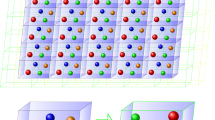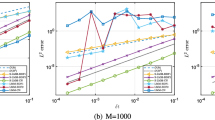Abstract
A method to calculate the stress distributions in a semi-infinite elastic body caused by molecular interactions has been established based on Mindlin’s solution. A molecular interaction force derived from the Lennard-Jones potential considering a one-dimensional periodic material distribution in the in-plane direction, i.e., x-direction, was used as a concentrated force in Mindlin’s solution. The stresses acting on the (100) and (001) surfaces (σx, σz, and τzx) for the distribution of two materials were calculated as a typical example of a periodic material distribution. The stress distributions were shown by color maps and the basic characteristics of the stress distribution, especially the effects of the surface distance, were quantitatively clarified. The asymptotic values of σx, σz, and τzx at the position far from the surface were analytically derived. Those of σx and σz had the same value, depending on the surface distance, while that of τzx was always zero. This difference comes from the existence of a non-fluctuation contribution.











Similar content being viewed by others
References
Bhushan B (1999) Handbook of micro/nano tribology, 2nd edn. CRC Press, Boca Raton. ISBN 0-8493-8402-8
Chang WR, Etsion I, Bogy DB (1987) An elastic-plastic model for the contact of rough Surfaces. ASME J Tribol 109:257–263
Chang WR, Etsion I, Bogy DB (1988) Adhesion model for metallic rough surfaces. ASME J Tribol 110:50–56
Chen G, Liu X, Chang JY (2015) Characterization of nonlinear, non-stationary, nano-scale surfing contact dynamics of TFC slider utilizing high order spectra detection. Microsyst Technol 21:2581–2587
Derjaguin BV, Muller VM, Toporov YP (1975) Effects of contact deformations on the adhesion of particles. J Colloid Interface Sci 53:314–326
Fukui S, Sato A, Matsuoka H (2012) Static and dynamic flying characteristics of a slider on bit-patterned media (dynamic responses based on frequency domain analysis). Microsyst Technol 18:1633–1643
Fukui S, Oono A, Matsuoka H (2013) Dynamic flying characteristics of an air bearing slider over a disk with grooves and distribution of material properties. Microsyst Technol 19:1685–1690
Huang Y, Yuan H, Kan W, Guo X, Liu C, Liu P (2017) A flexible three-axial capacitive tactile sensor with multilayered dielectric for artificial skin applications. Microsyst Technol 23:1847–1852
Innocenzi P, Malfatti L, Falcaro P (2015) Water droplets to nanotechnology: a journey through self-assembly. R Soc Chem. ISBN: 978-1-84973-664-0
Israelachvili JN (1972) The calculation of van der Waals dispersion forces between macroscopic bodies. Proc R Soc Lond Ser A 331:39–55
Israelachvili JN (1992) Intermolecular and surface forces, 2nd edn. Academic Press, New York
Johnson KL, Kendall K, Roberts AD (1971) Surface energy and the contact of elastic solids. Proc R Soc Lond Ser A 324:301–313
Juang J-Y, Wu W, Lin K-T (2014) Tribological impact of touchdown detection on bit patterned media robustness. Microsyst Technol 20:1745–1751
Kim SJ, Hwang DY, Moon H, Choi HR, Koo JC (2017) Development of a resistive compact slip sensor using dielectric elastomer. Microsyst Technol 23:5163–5169
Li L, Bogy DB (2011) Dynamics of air bearing sliders flying on partially planarized bit patterned media in hard disk drives. Microsyst Technol 17:805–812
Li N, Zheng L, Meng Y, Bogy DB (2009) Experimental study of head-disk interface flyability and durability at sub-1-nm clearance. IEEE Trans Mag 45:3624–3627
Li J, Xu J, Shimizu Y, Honchi M, Ono K, Kato Y (2010) Design and evaluation of damped air bearings at head-disk interface. J Tribol 132:031702
Lifshitz EM (1956) The theory of molecular attractive forces between solids. Soviet Phys JETP 2:73–83
Matsuoka H, Kato T, Fukui S (2002) Nanomeniscus forces in undersaturated vapors: observable limit of macroscopic characteristics. Langmuir 18:6796–6801
Matsuoka H, Ohkubo S, Fukui S (2005) Corrected expression of the van der Waals pressure for multilayered system with application to analyses of static characteristics of flying head sliders with an ultrasmall spacing. Microsyst Technol 11:824–829
Matsuoka H, Kitahama N, Fukui S (2013) Theoretical study of van der Waals dispersion force between macroscopic bodies with a periodic material distribution. Microsyst Technol 19:1661–1667
Matsuoka H, Kitahama N, Tanaka T, Fukui S (2014) Theoretical study of van der Waals dispersion pressures considering one-dimensional material distributions in the in-plane direction. Microsyst Technol 20:1397–1403
Matsuoka H, Kitahama N, Fukui S (2016) Theoretical study of surface interaction pressures of two-dimensional periodic material distributions based on the Lennard-Jones potential. Microsyst Technol 22:1419–1428
Matsuoka H, Tanaka T, Fukui S (2017) Theoretical study of surface interaction stresses considering one-dimensional material distributions in the in-plane direction based on the Lennard-Jones potential. Microsyst Technol 23:5247–5256
Matsuoka H, Miyake R, Maegawa S, Fukui S (2018) Theoretical analyses of surface interaction stresses considering two-dimensional periodic material distributions. Microsyst Technol 24:4649–4657
Maugis D (1992) Adhesion of spheres: the JKR-DMT transition using a Dugdale model. J Colloid Interface Sci 150:243–269
Mindlin RD (1936) Force at a point in the interior of a semi-infinite solid. J Appl Phys 7:195–202
Nakahara I, Shibuya H, Tsuchida E, Kasano H, Tsuji T, Inoue H (2001) Handbook of elasticity. Asakura Publishing Co. Ltd., Asakura
Ono K (2013) Design theory and vibration characteristics of a contact head slider. Microsyst Technol 19:1275–1287
Saeki F, Fukui S, Matsuoka H (2013) Thermocapillary instability of irradiated transparent liquid films on absorbing solid substrates. Phys Fluids 25:062107
Scherge M, Gorb SSN (2013) Biological micro- and nanotribology: Nature’s solutions. Springer, New York. ISBN: 978-3642074400
Sheng G, Xu J (2014) Nanoscale dynamics of MEMS TFC active slider. Microsyst Technol 20:1767–1770
Sinha SK, Satyanarayana N, Lim SC (2013) Nano-tribology and materials in MEMS. Springer, New York. ISBN: 978-3-662-50698-1
Stanley HM, Etsion I, Bogy DB (1990) Adhesion of contacting rough surfaces in the presence of sub-boundary lubrication. ASME J Tribol 112:98–104
Suh AY, Polycarpou AA (2007) Modeling of the effect of preferential texturing on the interfacial forces in sub-5 nm ultra-low flying head-disk interfaces. ASME J Tribol 129:553–561
Yeo CD, Katta RR, Polycarpou AA (2009) Improved elastic contact model accounting for asperity and bulk substrate deformation. Tribol Lett 35:191–203
Yeo CD, Katta RR, Lee J, Polycarpou AA (2010) Effect of asperity interactions on rough surface elastic contact behavior: hard film on soft substrate. Tribol Lett 43:1438–1448
Yoon Y, Talke FE (2010) Touch-down and take-off hysteresis of magnetic recording sliders on discrete track media. Microsyst Technol 16:273–278
Yoon Y, Talke FE (2014) Nano-tribology of discrete track recording media. Lambert Academic Publishing. ISBN: 9783659341489
Acknowledgements
This work was supported in part by the Japan Society for the Promotion of Science (Grant No. 15K05764) and Advanced Storage Research Consortium (ASRC). We thank Iain Mackie, PhD, from Edanz Group (www.edanzediting.com/ac) for editing a draft of this manuscript.
Author information
Authors and Affiliations
Corresponding author
Additional information
Publisher's Note
Springer Nature remains neutral with regard to jurisdictional claims in published maps and institutional affiliations.
Appendix: Mindlin’s solution
Appendix: Mindlin’s solution
The components of the matrix M, namely, Mindlin’s solutions for a unit concentrated force are shown here.
1.1 Normal stress on the (100) surface
For a unit concentrated force in the x-direction:
For a unit concentrated force in the z-direction:
1.2 Normal stress on the (001) surface
For a unit concentrated force in the x-direction:
For a unit concentrated force in the z-direction:
1.3 Shear stress on the (100) and (001) surfaces
For a unit concentrated force in the x-direction:
For a unit concentrated force in the z-direction:
where
and L is a specific length.
Rights and permissions
About this article
Cite this article
Matsuoka, H., Otani, T. & Fukui, S. Stress distributions in an elastic body due to molecular interactions considering one-dimensional periodic material distribution based on Mindlin’s solution. Microsyst Technol 26, 139–156 (2020). https://doi.org/10.1007/s00542-019-04537-6
Received:
Accepted:
Published:
Issue Date:
DOI: https://doi.org/10.1007/s00542-019-04537-6




